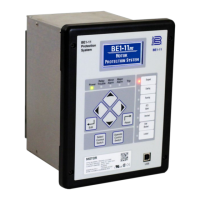9424200996 20-5
BE1-11m Thermal Curve (49TC) Protection
TCU = Present Thermal Capacity
TCU
end
= Thermal Capacity that the motor will eventually reach if current is maintained at present
magnitude.
TCU
start
= Thermal Capacity
T = Time since last calculation
τ = Cooling time constant (either running or stopped)
RTD Biasing and Hot/Cold Safe Stall Ratio
The thermal overload curves are based on the assumption of a normal 40°C ambient and normal motor
cooling. In the case of unusual ambient temperature or blocked or reduced motor cooling, the optional
installed RTDs can be used to improve the estimation of thermal capacity.
The user provides a curve showing RTD thermal capacity used. The curve includes a minimum of three
points and a maximum of 40 points. Three typical points are Ambient RTD Temperature (40°C) and 0%
TC, Full Load Amps running RTD temperature and thermal capacity, and Maximum Safe Stator RTD
temperature (typically 155°C).
Equation 20-7 is used to calculate the Full Load Amp thermal Capacity.
RTD Bias TCU = 1
hot safe stall time
cold safe stall time
Equation 20-7. RTD Bias TCU
RTD Bias TCU is linearly interpolated when RTD temperature is between defined temperatures.
When the 49TC is in overload and the RTD Bias TCU is higher than the current-based TCU, RTD Bias
TCU is used to update the 49TC thermal capacity. The current based model continues to calculate
thermal capacity from this new bias level. RTD Bias TCU alone will not result in a thermal model trip.
Current must be above the thermal model current pickup.
Overload and Trip
The Overload output occurs first, followed by the Trip output.
Overload
The 49TC pickup level is determined by the Overload setting along with the Service Factor and Full Load
Amps settings located on the System Parameters, Motor Configuration screen in BESTCOMSPlus. The
Overload output becomes true when the equivalent thermal current increases above the pickup current.
In BESTlogicPlus, the Overload output can be connected to other logic elements to annunciate the
condition, control other elements in logic, and start the fault recorder (logic element FAULTTRIG).
Assertion of the Overload output initiates a timer that begins timing to a thermal trip. The duration of the
timer is established by the thermal curve.
If the pickup condition subsides before the element delay expires, the timer and Overload output are
reset, no corrective action is taken, and the element is rearmed for any other overload conditions.
Trip
The Trip output becomes true if an overload condition exists for the duration of the element timer. In
BESTlogicPlus, the Trip output can be connected to other logic elements and to a physical relay output to
annunciate the condition and to initiate corrective action. If a target is enabled for the element, the BE1-
11m will record a target when the Trip output becomes true. See the Fault Reporting chapter for more
information about target reporting.
Emergency Start
When performing an emergency start, the Max Emergency Thermal Capacity setting determines the
maximum thermal capacity allowed. An emergency start is requested when the Emergency input of the
Motor Status logic block is true. The emergency start condition remains until the thermal capacity drops

